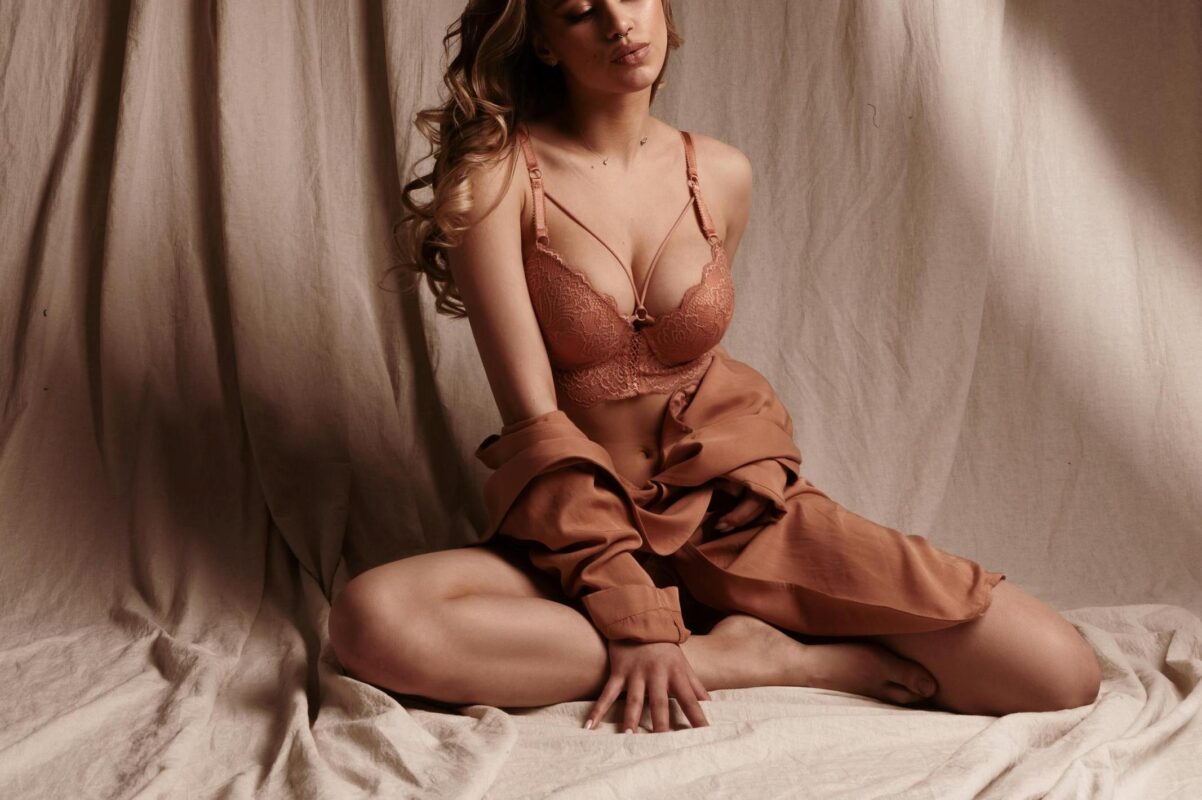In the realm of women’s fashion, underwear is no longer merely a functional basic. Increasingly, businesses attempt to design undergarments that blend comfort, style, and functionality—attributes that resonate with a broad audience of modern women. For clothing distributors and wholesalers, investing in custom underwear for ladies represents a strategic opportunity to attract new clients and diversify product offerings. Indeed, a well-curated collection of fabrics and designs can result in high-volume orders, frequent reorders, and a firm reputation for excellence.
But the process of mass producing bespoke underwear for women is more complex than many would have you know. Businesses have to strike a balance between the needs of modern consumers—who value things like breathability, eco-friendliness, stretch, and durability—with cost efficiency. Choosing less fabric can result in higher return rates, complaints, or a damaged brand image depending on the fabric. On the other hand, choosing exceptional materials will set your products apart in a saturated market and enable stores to support high pricing points.

In this article, we delve into the top fabrics for custom underwear for ladies, detailing the unique benefits each one brings to large-scale production. We will discuss fabric qualities, brand positioning benefits, and possible pricing issues from eco-aware bamboo to opulent lace and regular cotton. Understanding these choices helps distributors better match manufacturing capabilities and offer ideas that improve brand attractiveness. Whether you are a seasoned wholesaler or just starting out in the intimate clothing sector, these ideas will enable you to boost sales prospects and build lifetime customer loyalty.
Why Material Selection Is Crucial for Custom Underwear for Ladies
When placing mass orders of custom underwear for ladies, fabric choice directly influences quality, comfort, and perceived value—key variables that influence repeat business. Unlike outer clothing, underwear rests adjacent to the skin, accentuating the importance of softness, moisture control, and breathability. The following explains various reasons why your success depends mostly on the choice of materials:
Meeting Modern Consumer Expectations
Women of today demand more from intimate wear. Whether it’s daily business wear, sporty endeavors, or special events, they want underwear that supports many functions. One brand could have several lines, each aimed at a different consumer demand. Choosing fabrics fit for these needs (such as softer, hypoallergenic materials for sensitive skin or sweat-wicking for active lives) will help you to directly satisfy changing desires.
Enhancing Brand Identity
Fabric choice says volumes about brand identification for apparel wholesalers developing white-label or private-label collections. While one focused on luxury, a brand that promotes sustainability might rely on organic cotton or eco-friendly bamboo. Every choice tells end consumers a physical message, therefore extending the whole brand story.
Reducing Returns and Complaints
Customers typically become unhappy with fabrics that pill, tear readily, or stretch out of shape. Complaints can spread like snow, damaging your relationship with stores as well as the brand’s standing among end customers. In business-to- business clothing, repeat business is gold—clients that value your consistent quality become lifetime associates. Investing in correct materials and quality control will help you avoid regular returns or refunds.
Achieving Economies of Scale
Choosing cloths fit for large production simplifies production. Some materials handle cutting and sewing more effectively, therefore lowering manufacturing mistakes and waste. Manufacturing companies knowledgeable with particular fabrics usually run faster, more dependable operations—that translates to reduced labor costs and less delays. When you intend to manage large monthly shipments or scale, this efficiency becomes extremely important.
In short, fabric choice underpins each phase of creating custom underwear for ladies at scale. Your brand or distribution network may carve a presence in a market driven by comfort, performance, and aesthetic appeal by matching premium materials that fit client and consumer needs.
Cotton and Cotton Blends: Classic Solutions for Custom Underwear for Ladies
One of the most enduringly popular materials in intimate wear is cotton. Its natural, airy nature endears it to manufacturers promoting comfort and durability. While 100% cotton remains a cornerstone in underwear, several styles incorporate cotton blends that promote elasticity or reduce shrinkage over time. Below is an outline of why cotton—and its variations—dominate so many underwear collections.
Advantages of Cotton
- Breathability: Cotton’s porous structure allows air circulation, reducing heat buildup and odor.
- Hypoallergenic Qualities: Cotton rarely irritates skin, making it appealing for ladies with sensitivities or allergies.
- Softness and Familiarity: Most consumers have grown up wearing cotton garments, associating the fabric with comfort and everyday reliability.
- Wide Availability: In large-scale production, sourcing cotton is relatively straightforward—supply chains are well-established globally.
Introducing Spandex or Modal Blends
Many modern undergarments need, yet pure cotton can lack that elasticity. Manufacturers produce a more form-fitting garment that holds shape by combining spandex, sometimes known as elastane or Lycra. Another common blend element obtained from beech-tree pulp is modal, which adds silky smoothness and boosts moisture-wicking properties.
Considerations for Bulk Production
- Shrinkage Control: Pre-shrunk cotton or certain chemical finishes help minimize garment distortion after repeated washes.
- Cost Management: Cotton is often economical, but quality can vary widely. Higher-quality, combed cotton typically carries a premium price.
- Color Retention: Dyeing cotton can yield vibrant hues, but some lower-quality cotton might fade quickly. Evaluate colorfastness tests to ensure lasting vibrancy.
In many ways, cotton and cotton blends form a reliable foundation for custom underwear for ladies. From budget-conscious consumers to those giving softness and breathability first importance, their traditional charm appeals to a wide spectrum of consumers. You can decide if pure cotton or a tailored mix best fits your particular line by juggling comfort, affordability, and brand positioning.
Bamboo and Other Eco-Friendly Fabrics for Custom Underwear for Ladies
Sustainability has grown from a phrase to an actual selling feature in the garment market, especially in intimate wear. More people care about decreasing their carbon footprint and supporting eco-conscious brands. As such, eco-friendly fabrics—like bamboo, organic cotton, or hemp—have found their way into tailored underwear for ladies at scale.
Bamboo’s Rise in Popularity
Perfect for clothing that comes into close touch with the skin, bamboo fabric is hailed for its buttery softness, breathability, and antibacterial qualities. Environmentally conscious consumers will also find bamboo appealing since it grows rapidly with little pesticides. Retailers can emphasize these ecological qualities on packaging, therefore improving brand image and supporting premium price points.
Organic Cotton
Organic cotton appeals especially to consumers who value sustainability since it is a subset of cotton farmed free of synthetic fertilizers or pesticides. Certain certifications, including GOTS (Global Organic Textile Standard), support the environmentally friendly manufacturing of the goods more still. While appealing to ethical principles, the last garment has the familiar softness of cotton.
Hemp Blends
Though less frequent in women’s underwear, hemp’s antibacterial qualities and durability are helping it to become increasingly popular. Hemp can fit snug but breathable when combined with cotton or spandex. Hemp-based clothing commonly sees less wear and tear because of a softening with time texture.
Production and Market Implications
- Higher Costs: Organic cotton or bamboo fabrics often cost more than conventional cotton or synthetic fibers. Distributing these costs to stores calls for open communication of benefits including sustainability, great comfort, and brand narrative.
- Sourcing Complexity: Finding reputable suppliers who meet ethical and environmental standards can pose challenges. Audits and certifications guarantee you are working with real environmentally friendly manufacturers.
- Premium Brand Positioning: Underwear made from bamboo or organic cotton easily fits luxury or niche brand portfolios, as conscientious shoppers often pay a premium for Earth-friendly garments.
Selecting bamboo or other environmentally friendly materials will help your company be leader in ethical fashion. Developing confidence with end customers and stores can help you to create repeat business.demand among those who view sustainability as essential rather than a mere afterthought.

Lace, Microfiber, and Other Specialty Fabrics for Custom Underwear for Ladies
While some consumers lean toward refinement, elegance, or even performance characteristics, cotton and bamboo appeal to comfort and sustainability. Whether for daily confidence or special events, specialty fabrics—like lace, microfiber, and high-tech synthetics—expand the choice of personalized underwear for women you may sell.
Lace for a Luxurious Flair
Long associated with feminine beauty is lace. Women seeking visual intricacy and a sense of indulgence will find its delicate, complex look appealing. While commonly used for trims or overlays, some lines have all-over lace patterns. Lace panels can be included into cotton or mesh clothing by bulk buyers to create a hybrid look that strikes comfort and stylish balance. Consider high-quality lace for comfort; lower-grade lace might chafe or tear readily, causing discontent.
Microfiber for Sleek Comfort
Usually woven into a smooth, light-weight fabric, microfiber comprises of ultra-fine synthetic fibers—polyester, nylon, or a mix. Microfiber glides against the skin, lessens lines under outer clothing, and often wicks moisture in underwear. Microfiber can be rather popular among ladies who want minimum seams and a smooth silhouette since it resists pilling and holds color well.
High-Performance Synthetics
Advanced synthetics like nylon-spandex combinations save consumers looking for moisture control, odor resistance, or shape retention. Particularly pertinent in activewear collections, these materials help to close the performance-style divide. Some use technology like anti-odor treatments to guarantee the clothing feels new during several uses.
Considerations for Bulk Orders
- Cost vs. Perceived Value: Specialty fabrics can be more expensive, but they also offer higher margins if marketed effectively to a fashion-savvy audience.
- Testing for Comfort: Lace or synthetic materials must be carefully tested for skin comfort; ill-fitting edges or subpar finishing can irritate.
- Quality Control: Specialty fabrics sometimes require more rigorous manufacturing processes, including specialized sewing machines or finishing techniques.
Adding lace, microfiber, or performance-oriented synthetics lets you vary the women’s underline of underwear choices. Offering a mix of more opulent or athletic choices and more useful daily things, you satisfy the whole range of customer wants and generate more interest from stores wishing to carry several designs in one location.
Strategies for Selecting the Right Fabric Mix in Custom Underwear for Ladies
Combining market research, brand identity, and production feasibility will help you decide which fabrics to highlight in your ladies’ bespoke underwear collection. Here are practical ideas to direct your decision.
Conduct Thorough Market Analysis
Find out what your main audience likes. If your store network attracts younger, trend-driven customers, a rotation of strong designs in spandex or lace could find appeal. Give bamboo or organic cotton top priority for a base of environmentally sensitive consumers. Classic cotton mixes might also help daily comfort margins. Examining more closely demographic data, competitive products, and even social media interactions will help one choose the most relevant items.
Offer Tiered Collections
If you serve diverse markets, consider segmenting your underwear range into distinct tiers:
- Entry-Level Basics: Cotton or cotton-blend garments with straightforward cuts, targeting affordability.
- Mid-Range: Possibly featuring microfibers or spandex blends for improved comfort and fit.
- Premium or Luxury: Incorporating lace trims, bamboo, or advanced finishes suitable for more demanding or trend-conscious consumers.
Such a tiered approach not only appeals to multiple price points but also encourages customers to trade up to higher-margin lines as brand loyalty grows.
Factor in Production Timelines
Different textiles could alter your manufacturing or shipment timetables. Lace and specialist synthetics may demand more time for stitching and finishing. If you plan seasonal launches—e.g., a Valentine’s collection or a summer sportswear line—factor in potential lead time extensions. Build buffers within your production calendar, so retailers can get merchandise well before they plan to promote it.
Negotiate Responsibly with Suppliers
Think about bulk orders and ask each fabric for sample yardage. Run test batches with your manufacturer to guarantee early resolution of any special seam or finishing requirements. Clarify reorder options: should demand surge cause your supplier to rapidly refill raw materials? Strong supplier ties will let you pivot more quickly to follow last-minute design changes or shifting trends.
Communicate Fabric Benefits Clearly
Ultimately, provide strong marketing tools and hang tags outlining the benefits of each fabric to help stores sell your underwear. Emphasize, for example, organic certification of your bamboo fabrics or odor-control treatments. Key benefits in a saturated market include increased end-consumer trust and brand loyalty, which this openness helps to build.
Conclusion
Success for custom underwear for women depends mostly on fabric choice, which affects user happiness as well as manufacturing results. Whether your preferred style is classic cotton, environmentally friendly bamboo, luxurious lace, or high-performance synthetics, the correct one will turn plain undergarments into a profitable product line. Matching textiles to brand identity, market needs, and quality standards will help your clothing company go steadily forward.
Female consumers of today look for undergarments that fulfill their need for comfort, fashion, and ethical behavior. Meeting those needs calls for careful preparation, thorough supplier screening, and exacting quality control. Still, the benefits are broad: B2B purchasers favor partners who consistently deliver, inspire creativity, and predict changing tastes. Your brand identification changes as you improve your products by adding fresh fabric technology or stretching design limits, thereby creating close relationships with end users and stores both.
At Modenly, our area of expertise is helping distributors and resellers through every stage of large-scale underwear manufacture—from idea to final delivery. Using our knowledge of market analysis and fabric procurement can help you create collections that appeal to contemporary women.n, stay ahead of industry trends, and build a loyal customer base that returns for seasonal updates and new designs.
FAQs
- How do I determine which fabrics will best suit my target demographic in ladies’ custom underwear?
First, do targeted market research. Find out whether your consumers give style, comfort, sustainability, or price first priority. A younger, trend-conscious clientele could value lace and strong designs, for example, whereas a business emphasizing wellness or minimalism would choose bamboo or organic cotton. Confirming these observations can be done with surveys, competition studies, and retail partner comments.
- Are eco-friendly fabrics like bamboo and organic cotton too expensive for bulk production?
Although these materials are usually more expensive than conventional cotton or synthetics, many customers are ready to pay extra for eco-friendly clothing. If you can clearly convey the environmental advantages, this will convert into better profit margins. To balance the extra cost, negotiate volume discounts with vendors and present the line as a premium or specialized product.
- What is the best way to avoid quality issues in mass-producing ladies’ custom underwear?
Give supplier choice top priority by confirming strong quality-control procedures and experience with intimates. To evaluate seam and thread compatibility, ask for sample yards. During manufacturing, routinely do spot inspections with an eye toward factors including stretch retention, uniform stitching, and color fastness. Early identification and correction of problems lower the possibility of major flaws in final goods.
- Should I include spandex in all my underwear lines for better stretch?
Not essentially. Styles like briefs or sports-oriented lines that call for a close fit or shape retention benefit from spandex. Still, some customers might appreciate the drape of modal while others would want the breezy simplicity of pure cotton. Providing several fabric compositions helps you to satisfy different tastes and increase your possible market.
- How do I create a strong selling proposition when working with retailers?
Emphasize exceptional qualities include eco-friendly certifications, unusual materials, or creative finishing methods. Provide digital tools, tags, pamphlets, or product education materials highlighting the main benefits of the clothing. Showing that your brand is ready to meet customer needs—softness, sustainability, style, or otherwise—helps stores to highlight your line and place bigger orders.
Interested in leveraging top-quality fabrics for your next bulk order of custom underwear for ladies? Modenly offers expert production support, from sourcing eco-friendly textiles to refining premium lace details. Contact us today to elevate your apparel portfolio.

